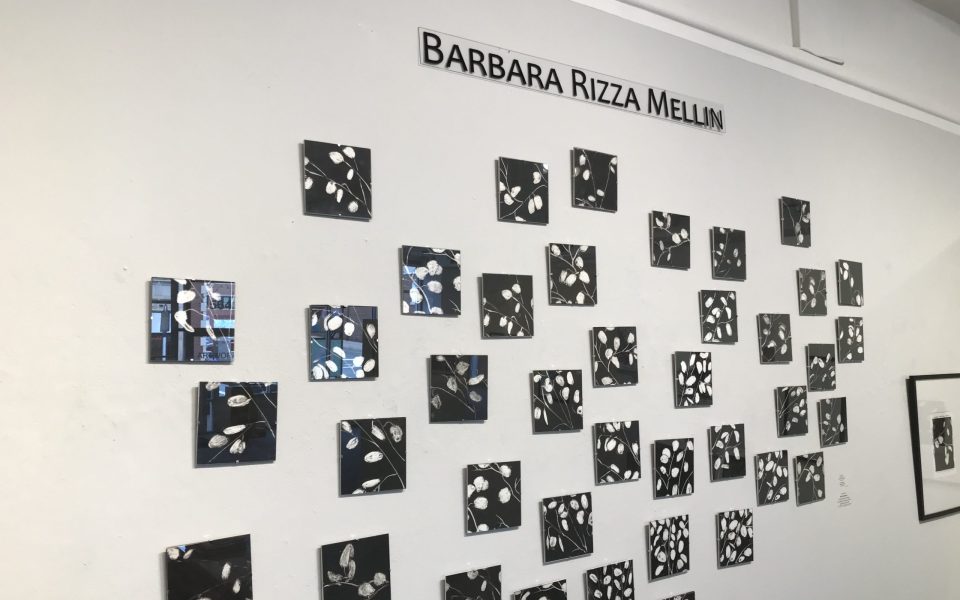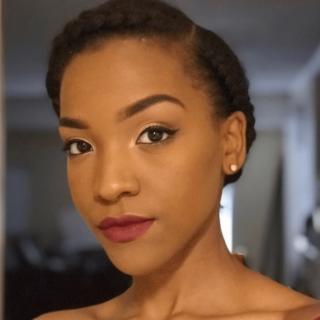(featured photo by Michaela Ratliff)
“With glowing daydreams, translucent lunaria brighten my morning.”
Winston-Salem artist Barbara Mellin emphasizes her carborundum print images of the lunaria plant’s silvery, translucent seed pods by writing corresponding haikus for each image.
“I decided to add the haikus in a simple, personal script, without a lot of flourishes, which seemed suited to the nature of the Lunaria,” Mellin says.
Mellin’s latest exhibit, Lunaria: Carborundum Mezzotints and Original Haikus, hangs from the walls on the left side of Winston-Salem’s Artworks Gallery. The exhibit is comprised of two components, the first being 16 framed 20-by-16 inch carborundum mezzotint prints of the lunaria plant — also known as “honesty” or “money plant” — from various angles. Next to each of the prints is an original haiku in Mellin’s cursive handwriting, designed to add context to the images as they are visually similar.
“They’re delicate,” she says. “They’re so basically black and white that I wanted each one of them to have a personality that would come through and be unique.”

The second element of the exhibit is a wall installation of 48 6-inch square, mezzotint glass-framed images of the lunaria arranged in the shape of the actual plant that sits on a podium to the installation’s left. The borders of the images never touch, allowing the viewer’s eye to follow the arrangement and envision the plant’s branches to complete the picture.

Mellin began working on the project in January 2020. She didn’t work continuously, finishing just a few prints before taking a break at the beginning of the pandemic. At its height, she completed the rest of the images. For that, she calls the show a “quarantine creation.”
Inspired by her love of mezzotints from the Baroque Period, Mellin used her own press in her home studio to create the carborundum print collection. She values printmaking because of the labor required to do it.
“There’s a physicality to it,” she says. “It’s just very tactile.”
Each image was made by forcing carborundum, a gel-like substance made of silicon and carbon, through a silk screen onto an acetate printing plate. In a brief window of 15 minutes, Mellin carves the image into the gel using a bamboo scraping tool. She then inks the entire image, wiping ink from its carved parts. Finally, a damp sheet of paper is placed onto the plate and into the press, leaving a textured, black and white image. The carbon in carborundum creates a rich shade of black Mellin believes is unmistakably eye-catching.
“That’s what I loved about this is that really velvet dark of the black,” she says.
Mellin originally wanted to do just one print of the lunaria plant but her adoration of both the plant and the art of printmaking quickly became a collection of images, leading her to host the exhibit.
“I usually find something I love and expand on it,” she says.
Each 20 by 16-inch image is simply titled “Lunaria,” followed by the number of the order in which it was created and two standout words from its corresponding haiku. “Lunaria 58: Touchable Moonlight” captures the intricacy of the seed pods of the lunaria plant. Seven pods extend from a group of various branches. A single remaining seed can be seen in the pod of the center of the image. To its right is the haiku “Touchable Moonlight.”
All the more treasured
for their delicate nature,
Touchable moonlight.
Barbara Mellin
The poem, in Mellin’s words, accentuates the fragility, yet tangible beauty of the plant.

Though it doesn’t happen often, Mellin writes poetry after finding inspiration in her everyday life. After reading Driveway Chalk Stars of Pajama Astronomers: A Year of Haiku by her son Jeff, she wanted to try her own hand at the craft of telling a vivid story in just a few lines.
“When you want to say something in a short form that’s too long to express, you can say it in poetry,” she says.
Mellin has been an artist most of her life, earning a graduate degree in art history from Harvard University, a feat that according to Mellin, isn’t impossible.
“Sure, it’s hard, but it’s not undoable,” she says.
During her time in Boston, she founded the Young Artists Studio and worked as an art instructor for more than 20 years.
She relocated from Boston to Winston-Salem almost a decade ago, citing the need for new adventures during she and her husband’s retirement years. They searched for an area where they could experience diverse weather with museums and an active entertainment scene.
“Winston-Salem just fit the bill,” she says. “We had never been here before, but we love it.”
Mellin quickly inserted herself into the Triad’s art scene, joining Artworks Gallery three years ago. Past and present professional memberships include the Art for Arts Sake group, Winston-Salem Writers, Piedmont Print Co-op in Greensboro and many others.
“I really feel like I’m a part of the community,” she says.
Lunaria: Carborundum Mezzotints and Original Haikus is available to view at Artworks Gallery until March 28. To learn more about Barbara, visit BarbaraRizzaMellin.com. Lunaria prints are available to purchase from Artworks Gallery’s shop.
Join the First Amendment Society, a membership that goes directly to funding TCB‘s newsroom.
We believe that reporting can save the world.
The TCB First Amendment Society recognizes the vital role of a free, unfettered press with a bundling of local experiences designed to build community, and unique engagements with our newsroom that will help you understand, and shape, local journalism’s critical role in uplifting the people in our cities.
All revenue goes directly into the newsroom as reporters’ salaries and freelance commissions.


Leave a Reply